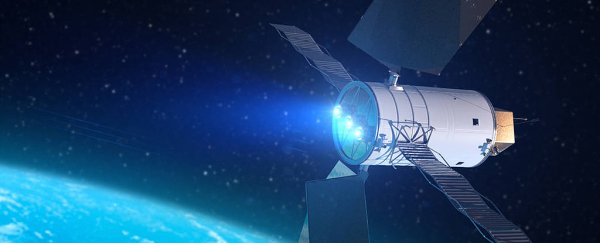It's official - NASA's Asteroid Redirect mission has entered its closing down phase, which means we can't expect to see a giant boulder orbiting our Moon any time soon. Bummer.
Asteroid Redirect was started in 2015 with the goal to create the first-ever mission combining robot and human efforts. The plan was to send a robotic crew to a near-Earth asteroid, grab a huge rock from it, and redirect it in a stable orbit around the Moon.
Then in the 2020s astronauts were going to use this multi-ton boulder for testing out technologies and methods intended for the eventual Mars mission. On top of that, the asteroid chunk could also be used for practicing commercial space mining and even testing out planetary defence methods.
But the space agency's latest budget reshuffle has put a halt to these efforts. At the annual NASA Small Bodies Assessment Group (SBAG) meeting earlier this week, the mission program director Michele Gates outlined the next steps now that the amazing asteroid fetch is definitely not happening.
"We are in an orderly closeout phase, capturing all the good work that's been done across the team," said Gates. "It was really aspirational for many of us and I appreciate your partnership as we moved through phase A and phase B."
Asteroid Redirect was a complex endeavour requiring expertise from disparate research centres across NASA. Gates praised the excellent collaboration across all the teams involved in the first stages of the mission.
The mission was actually proceeding according to plan up until last September when US Congress approved NASA's latest budget, forcing a reevaluation of some of its missions, including Asteroid Redirect.
In March this year, NASA acting administrator Robert Lightfoot released a statement concerning the budget proposal, saying that the overall funding had remained stable, but that the agency would have to reshape their focus on its available resources.
"We remain committed to the next human missions to deep space, but we will not pursue the Asteroid Redirect mission with this budget," he said.
"This doesn't mean, however, that the hard work of the teams already working on ARM will be lost. I have had personal involvement with this team and their progress for the past few years, and am extremely proud of their efforts to advance this mission."
As Jeff Foust reports for Space News, Asteroid Redirect was struggling to win support from the US Congress ever since its introduction, and some members are happy to see it gone:
"It's good to see that the NASA budget request ends the previous administration's ill-conceived asteroid mission," said Rep. Lamar Smith (R-Texas), chairman of the House Science Committee, during a June 8 hearing by his committee's space subcommittee on the NASA budget request.
Thankfully, the researchers say they are documenting their efforts so the work of the past six years is not lost. In fact, some of the developments for the mission will continue - notably, scientists are still working on developing a solar-electric propulsion system. It was originally intended for the robotic asteroid trip, but could still be used for other NASA projects.
Asteroid Redirect mission investigator Dan Mazanek stated at the SBAG meeting that the technologies the researchers were developing were not all mission-specific.
"I haven't come up with anything that we were doing that was not applicable to a wide variety of missions," he said. But he and colleagues are certainly disappointed.
"This was a dream mission as far as I was concerned, because my interest has always been in human exploration, planetary defence, science, and I'm a firm believer we have to use in situ resources if we're going to settle and expand out in the Solar System."
"I still think it's a good mission," said Mazanek.
Of course, space exploration is tricky and often expensive business, and a huge agency like NASA has to do the best with the resources it has.
But we were definitely looking forward to a giant boulder in the Moon orbit, so, along with Mazanek, we're hoping that one day Asteroid Redirect might return in a new format.
